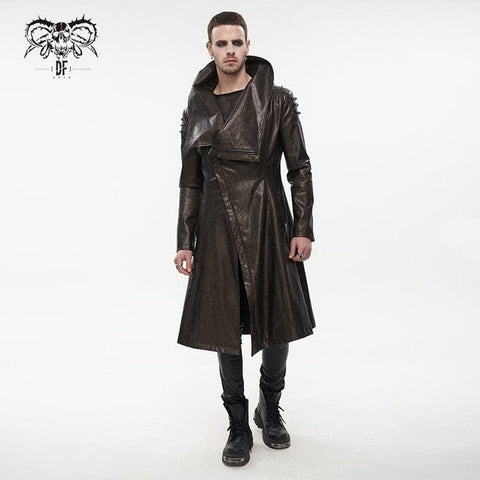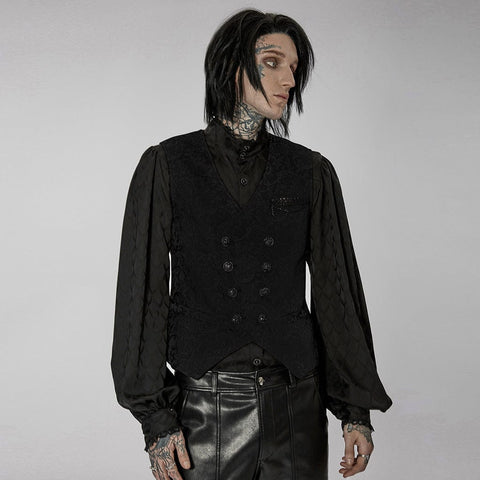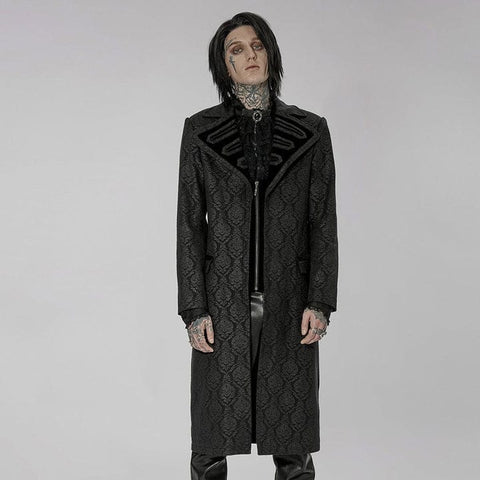Punk and Goth are captivating the hearts and minds of countless individuals seeking to express their unique identities and push societal boundaries. These two subgenres rooted in rebellion and nonconformity, have left an indelible mark on the fashion, music, and lifestyles of those who proudly associate themselves with these movements.
While both Punk and Goth subcultures share a rebellious spirit and a penchant for unconventional styles, they are not the same. These two subcultures have their distinct origins, aesthetics, philosophies, and influences that set them apart in the tapestry of alternative culture. Join Punk Design on a journey as we delve into the world of Punk and Goth, exploring their histories, their defining characteristics, and the subtle (and not-so-subtle) differences that make each subculture a unique and vibrant entity in its own right.
Punk vs. Goth: Historical Roots
Punk and Goth are two distinct subcultures that have made a significant impact on music, fashion, and even societal attitudes. Both movements emerged in the latter half of the 20th century, reflecting the rebellious spirit of their respective eras.
Origins and Development of Punk
Punk's origins can be traced back to the late 1960s and early 1970s, with roots in both the United States and the United Kingdom. In the U.S., bands like The Stooges and The MC5 laid the groundwork for punk's aggressive sound and rebellious ethos. Meanwhile, the New York Dolls introduced glam rock music elements into the mix.
The punk movement gained momentum in the mid-1970s, particularly in the UK, where bands like The Sex Pistols, The Clash, and The Damned spearheaded the Punk revolution. The Ramones, hailing from the U.S., were instrumental in shaping the genre with their minimalist, high-energy music. Punk was marked by its DIY (Do-It-Yourself) ethos, anti-establishment sentiment, and raw, often confrontational music.

Origins and Development of Goth
Goth movements emerged in the late 1970s, primarily in the UK. Its roots can be traced to the post-punk and new-wave music scenes. Bands like Siouxsie and the Banshees, Bauhaus, and Joy Division played a crucial role in shaping the Gothic sound, characterized by moody, atmospheric emo music with introspective lyrics.
The 1980s saw the development of the Goth culture as it expanded beyond music to encompass fashion, art, and a distinct lifestyle. Goths embraced a darker aesthetic, favoring black clothing, heavy makeup, and gothic architecture-inspired jewelry. Gothic literature and cinema also played a significant role in shaping the subculture's identity.

Punk vs. Goth
Punk is characterized by its aggressive, high-energy music and a DIY ethos. It is a reaction against the status quo and often confronts societal issues head-on. Punk fashion tends to be more utilitarian and chaotic, emphasizing the rejection of mainstream trends.
Goth, on the other hand, embraces a darker, more elegant aesthetic. It is introspective and often explores themes of beauty in darkness and the melancholic. Gothic fashion is highly stylized and often intricate, emphasizing individuality and creativity.
Punk vs. Goth: Music
Music has always been a powerful medium for expressing emotions, thoughts, and ideologies. Two subcultures that have made a significant impact on the music genre are Punk and Goth. While both originated in the 1970s and share some similarities in their alternative lifestyles and rebellious attitudes, their music diverges into distinct territories.
Punk Music
Punk music is characterized by its blistering, high-energy, and raw sound. It's a genre that thrives on simplicity, often featuring short and straightforward chord progressions. The driving force behind punk rock music is its urgency, with short, intense bursts of musical aggression. The tempo is typically fast-paced, and the instrumentation is stripped down to its bare essentials, usually including guitars, bass, drums, and vocals. Punk's simplicity and rawness make it accessible to both musicians and listeners alike.
One of the defining features of punk music is its commitment to addressing social and political issues head-on. Punk bands often use their music as a platform to critique the establishment, challenge authority, and protest against injustice. Lyrics can be confrontational, rebellious, and unapologetic, reflecting the frustration and anger of the youth. Iconic punk bands like The Clash and Dead Kennedys delivered powerful social commentaries through their songs, such as "London Calling" and "Holiday in Cambodia."
Bands and Songs:
The Ramones - "Blitzkrieg Bop"
Sex Pistols - "Anarchy in the U.K."
The Clash - "Rock the Casbah"
Dead Kennedys - "California Über Alles"
Black Flag - "Rise Above"
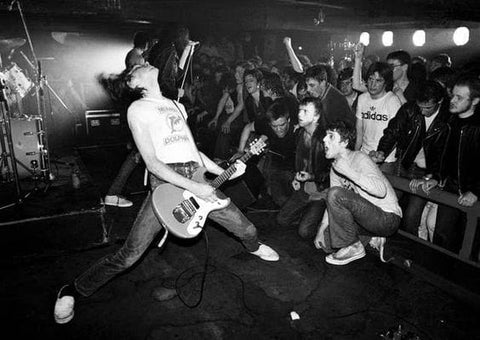
Goth Music
Goth music like emo music takes a stark departure from the fast and raw energy of punk. It embraces a melancholic and atmospheric sound characterized by its haunting melodies. Gothic music often incorporates synthesizers, reverb-drenched guitars, and ethereal vocals to create a sense of brooding darkness. This music genre is all about ambiance, often evoking a sense of mystery and otherworldly beauty. Gothic rock another goth music genre involves the expression of emotional themes through introverted/extroverted methods in music.
Goth delves deep introspective and romantic lyrics into love, macabre, and dark themes. They explore the complexities of human emotions, often tinged with a sense of longing and despair. While gothic music can be introspective and melancholic, it doesn't necessarily shy away from celebrating the darker aspects of life. Bands like The Cure and Bauhaus are known for their poetic and introspective lyrics, exemplified by songs like "Love Song" and "Bela Lugosi's Dead."
Bands and Songs
Siouxsie and the Banshees - "Cities in Dust"
The Cure - "Lovesong"
Bauhaus - "Bela Lugosi's Dead"
Sisters of Mercy - "This Corrosion"
Joy Division - "Love Will Tear Us Apart"
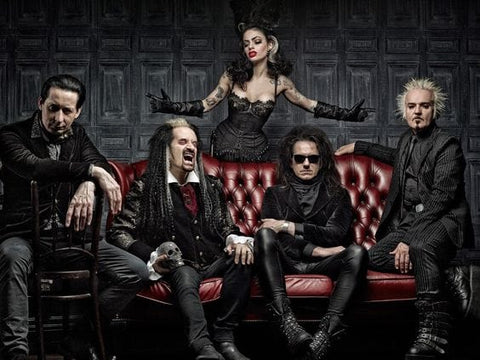
Punk vs. Goth
Punk and Goth music may have emerged from the same era of rebellion and alternative lifestyles, but their musical expressions couldn't be more different. Punk's fast-paced, raw, and socially charged sound stands in stark contrast to goth's melancholic, atmospheric, and introspective melodies.
Punk vs. Goth: Fashion
Punk and Goth share some common elements, like their rejection of mainstream fashion and a penchant for black attire, but they also diverge in significant fashion styles.
Punk Style
Punk style is synonymous with a Do-It-Yourself (DIY) ethos that rebels against mainstream consumerism and conformity. Punks often take pride in creating their clothing and accessories, showcasing a raw and unpolished look. Safety pins, patches, and hand-painted slogans are common elements used to customize clothing, adding a personal touch to their outfits. This DIY approach allows punks to express their individuality and creativity, reflecting their resistance to conforming to societal norms.
Punk clothing often features provocative messages and symbols that challenge the status quo. Leather jackets adorned with studs and spikes, black skinny jeans, and band tees from punk rock bands like The Ramones or The Sex Pistols are iconic staples of this rebellious style.
Punk fashion revolves around the iconic combination of leather and denim. Leather jackets and vests are often adorned with an array of studs, spikes, and band patches, giving them a distinct rebellious edge. Denim vests, too, serve as a canvas for personalization, with punks attaching various patches and pins that reflect their favorite bands, political beliefs, or personal statements. These leather jackets and vests are typically worn over ripped clothing such as graphic tees that further communicate the punk ethos.
Wearing band t-shirts is a cherished tradition among punks. These shirts feature the logos and artwork of punk bands, serving as both a homage to musical influences and a form of personal expression. Band tees are often distressed, customized, or torn to showcase a weathered, DIY aesthetic. They are worn proudly to concerts and gatherings with ripped jeans or casual skirts, becoming badges of belonging within the punk subculture.
Footwear is a crucial element of punk fashion, and combat boots reign supreme in this realm. These chunky, lace-up boots provide both a rugged and stylish look. They are durable, comfortable, and capable of withstanding the mosh pits and protests that punks often find themselves in. Customization is common, with punks adding their flair through paint, studs, or laces in vibrant colors.
Goth Style
Goth fashion, in stark contrast to punk, embraces a dark and dramatic aesthetic. Goths are known for their affinity for dark-colored clothing, which symbolizes mystery, melancholy, and a connection to the macabre. The gothic style draws inspiration from the Victorian and Romantic eras, embracing elaborate and ornate details that create an aura of sophistication and mystique.
The goth aesthetic has a deep of the Victorian and Romantic periods, evident in their clothing choices. To achieve a classic Gothic silhouette, corsets and vests are frequently worn. These garments cinch the waist and create an hourglass figure, echoing the elegant and structured fashion of the Victorian era. Corsets are often adorned with intricate lacing or ornate designs, reminiscent of the Victorian era's elegance.
Goth fashion is synonymous with a dark and moody color palette. While black is the predominant choice, Goth people also incorporate light purples, dark reds, baby blues, and occasionally forest greens to add depth to their pastel goth outfits. This somber color scheme contributes to the subculture's mysterious and enigmatic allure, echoing themes of darkness and melancholy.
Two of the most prominent fabrics in Gothic fashion are lace and velvet. These materials evoke a sense of romanticism and sophistication, drawing inspiration from the Victorian era. Goths often incorporate lace trims and overlays into their garments, while velvet is used for shirts, coats, and accessories. The juxtaposition of these fabrics with the overall dark theme creates a sense of ethereal beauty.
Goths are known for their distinctive makeup choices, which often involve heavy use of dark eye makeup and lipstick. This makeup enhances the dramatic and mysterious aura associated with the subculture. In terms of accessories, Goths adorn themselves with an array of silver jewelry, including ornate crosses, pentacles, and Gothic-themed pieces. Chokers, often featuring intricate designs or symbolic pendants, are also a common accessory choice. These accessories complete the Gothic look, adding depth and symbolism to the overall style.
Punk vs. Goth
While punk fashion is characterized by its DIY aesthetic, bold anti-establishment statements, and rough edges, goth fashion embraces darkness, elegance, and an affinity for the past. Both subcultures continue to influence and inspire alternative fashion, reminding us that fashion is not just about clothing; it's a form of self-expression and a powerful tool for challenging the status quo.
Punk vs. Goth: Lifestyle and Spirit
Punk and Goth both emerged in the late 20th century as reactions to societal norms, but they diverged into distinct philosophies, aesthetics, and ways of life.
Punk Philosophy
Anarchistic and Rebellious Ethos: Punk is perhaps best known for its rebellious spirit and its vehement rejection of authority and conformity. Rooted in the discontent of the late 1970s, punk arose as a reaction to political and social issues. It was a defiant cry against the establishment, with a rallying call to question everything.
Punk has always championed the Do-It-Yourself (DIY) ethos. Whether it's creating music, fashion, or art, punks value self-expression above all else. This ethos encourages individuals to be fearless in pursuing their passions, even if it means defying societal norms.
Beyond its rebellious exterior, punk has a deeply rooted sense of social consciousness. Punk bands often use their music as a platform for addressing social and political issues, and advocating for change. This activism can take the form of benefit concerts, fundraisers, or direct action.
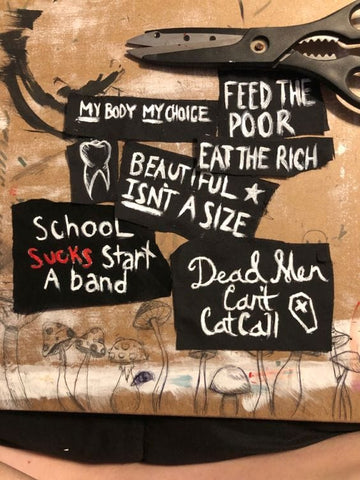
Goth Philosophy
The Goth subculture takes a different path. Goths are drawn to the darkness, both in their aesthetic choices and philosophical outlook. They embrace the macabre, finding beauty in the shadows and the mysterious. This aesthetic is reflected in their clothing, art, and even their music.
Goths are known for their strong sense of individualism and introspection. They tend to be deep thinkers, often exploring existential and philosophical themes. The goth lifestyle encourages individuals to delve into their inner selves and embrace their uniqueness.
Many Goths are intrigued by the supernatural and occult. This fascination often extends to literature, art, and even spiritual practices like Wicca. Goths find solace in the mysterious and the unknown, using it as a source of inspiration and spiritual exploration.
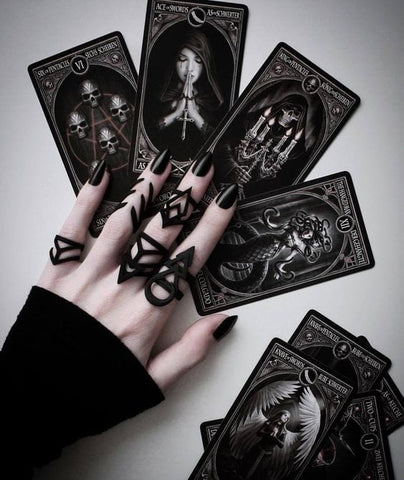
Punk vs. Goth
Punk rooted in the raw energy of music, embraces a defiant spirit with DIY ethos, celebrating a rejection of mainstream norms. In contrast, the Goth subculture revels in dark romanticism, finding beauty in the macabre, often accompanied by elaborate makeup and a fascination with the mysterious and supernatural.
Punk vs. Goth: Substyles
Substyles have always been a fascinating facet of society, offering a platform for individuals to express their unique identities and beliefs. Two such subcultures that have left a lasting impact on music, fashion, and lifestyle are Punk and Goth. While both emerged in the 1970s as rebellious countercultures, they have evolved over the years, giving birth to other styles.
Punk Substyles
Pop-punk is a lighter, more melodic offshoot of traditional punk. It combines the raw energy and ethos of punk with catchy melodies and often deals with themes like adolescence, relationships, and everyday struggles. Bands like Green Day, Blink-182, and Sum 41 are iconic in the pop-punk genre. It typically includes graphic tees, skinny jeans, and vibrant hair colors.
Hardcore punk takes the aggression of punk to the extreme. It's characterized by blistering speed, intense lyrics, and a DIY (do it yourself) attitude. Bands like Minor Threat, Bad Brains, and Black Flag are pioneers in this genre. Post-hardcore punks often sport shaved heads, band t-shirts, and tattoos. The subculture places a strong emphasis on emotional expression.
Street punk, also known as Oi! It's characterized by a rough and aggressive sound with lyrics that focus on working-class struggles, street life, and social issues. Bands like Cockney Rejects and Sham 69 are prominent in this substyle. Street punks often adopt a working-class aesthetic with denim jackets, boots, and shaved heads.

Goth Substyles
Cybergoth is a futuristic and visually striking substyle of goth that incorporates elements of cyberpunk and rave culture. Neon-colored hair, intricate cybernetic accessories, and elaborate makeup are common features of cybergoth fashion. Music in this subculture often blends electronic and industrial genres. Artists like Combichrist and Grendel appeal to cybergoth enthusiasts.
Vampire Goth, as the name suggests, draws its inspiration from gothic literature, folklore, and the romanticized image of vampires. It emerged as a substyle within the broader goth substyle in the late 20th century. It often embraces Victorian-era fashion. This includes elaborate, often dark, and opulent clothing, such as bat capes, long flowing skirts, lace-up boots, and high-collared blouses. Accessories play a crucial role in completing the Vampire Goth look. Think about velvet chokers, antique jewelry, and elaborate headpieces.
Lolita Goth is a fusion of Japanese Lolita fashion and gothic aesthetics. It incorporates gothic elements into the traditional Lolita fashion. This includes frilly dresses, petticoats, knee-length socks or tights, and Mary Jane shoes. The clothing always has a darker color palette, often featuring black as the dominant color, lace detailing, and accessories like bows, ribbons, and crosses.

The debate between Punk and Gothic styles has been ongoing for decades, and while both subcultures share a rebellious spirit and a love for alternative fashion, they are distinct in their ways. As we've explored in this blog, Punk tends to embrace a more DIY ethos, with its roots in anti-establishment, anti-authoritarianism, and a loud, chaotic aesthetic. On the other hand, Goth fashion leans towards a darker, romantic, and more melancholic aesthetic, often associated with a fascination for the mysterious and macabre.
At our store, we understand the importance of catering to both these unique fashion sensibilities. Whether you're a die-hard Punk enthusiast or a devoted member of the Goth subculture, you can find a wide range of options in our collection. From goth clothing that embodies the elegance of the night to punk clothes that scream rebellion, we've got you covered.
We're constantly updating our inventory with new arrivals to ensure that you have access to the latest trends and timeless classics. So, sign in and explore the ever-evolving world of alternative fashion or simply browse for inspiration, our store is your go-to destination.

